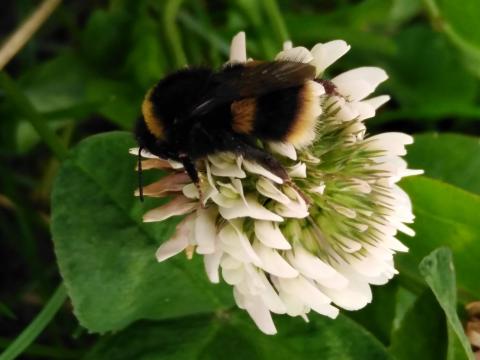
"Agricultural grasslands are often species-poor, but do they have to be like that?"
This experiment is investigating whether increasing the number of plant species in grazed grasslands can help other biodiversity and increase the quality of the forage.
Background to this work. One of the gaps we identified in the current Scottish Agri-Environment and Climate Scheme is an option for farmers to diversify their typical grasslands to improve biodiversity. There are Scheme-options for managing species-rich grassland, but this is a relatively rare habitat today and leaves most grass-based farming operations with fewer Scheme-options to bid for compared to arable farmers. We also identified that there were few options specifically focussed on pollinators.
So, how to integrate flowers for pollinators into a system where these flowers will be grazed off by livestock?
We took the view that many plant species will respond quickly to a removal of grazing by growing taller and flowering, so that the area will become a hotspot for pollinator activity. Increasing local pollinator populations would need multiple fields grazed at different times to ensure a constant availability of pollen and nectar.
Our sward diversification experiment. We established the experiment in spring 2018. We chose five treatments:
- do nothing (control),
- harrow only (to assess the impact of disturbance),
- harrow and add white clover,
- harrow and add a diverse mixture of legumes, and
- harrow adding a diverse mixture of legumes and other flowering species. Using legumes should reduce the need for fertiliser and they are also well known for having nutritious pollen and nectar. However, they may not be attractive to all potential pollinators.
The use of different seed mixtures will give us an idea of what plant species establish best and what plant species the pollinators are using. Following the plots through time will give us information on what species persist in the system under grazing and can continue to be useful for pollinators whenever the sward is rested.
We have put together a summary of the results so far, but the main things to come out of the experiment are:
- White clover established well, but the only other legume to establish significantly was Bird’s foot trefoil. Of the other sown species, yarrow was the best species to establish.
- Sowing species into the sward increased resources for pollinators.
- Diversifying the sward had no detectable impact on the numbers of pollinators observed on the different treatments. Either there were insufficient rest periods between grazing periods, the numbers of pollinators present in the vicinity of the experiment were too limited to show a strong response or there was better resources elsewhere.
- Sowing White clover improved forage quality by reducing fibre and increasing protein, though lignin increased. The diverse legume mix increased lignin but raised protein content, whilst the diverse forb mix reduced overall fibre but increased lignin, whilst marginally increasing protein.
The global context. Continuing biodiversity loss is a feature around the globe and recently much attention has been focussed on the rapid declines seen in insect populations. This is true for pollinators in the UK, where there have been substantial declines in the range of many species - action for pollinators is now an urgent Government priority.
For more information please contact Robin Pakeman or Jenni Stockan.
